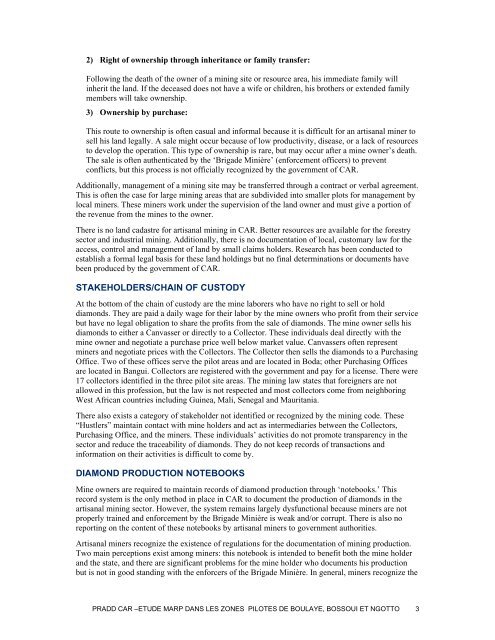PRADD Rapport d'Etude MARP dans les Zones - Land Tenure and ...
PRADD Rapport d'Etude MARP dans les Zones - Land Tenure and ...
PRADD Rapport d'Etude MARP dans les Zones - Land Tenure and ...
- No tags were found...
Create successful ePaper yourself
Turn your PDF publications into a flip-book with our unique Google optimized e-Paper software.
2) Right of ownership through inheritance or family transfer:Following the death of the owner of a mining site or resource area, his immediate family willinherit the l<strong>and</strong>. If the deceased does not have a wife or children, his brothers or extended familymembers will take ownership.3) Ownership by purchase:This route to ownership is often casual <strong>and</strong> informal because it is difficult for an artisanal miner tosell his l<strong>and</strong> legally. A sale might occur because of low productivity, disease, or a lack of resourcesto develop the operation. This type of ownership is rare, but may occur after a mine owner’s death.The sale is often authenticated by the ‘Brigade Minière’ (enforcement officers) to preventconflicts, but this process is not officially recognized by the government of CAR.Additionally, management of a mining site may be transferred through a contract or verbal agreement.This is often the case for large mining areas that are subdivided into smaller plots for management bylocal miners. These miners work under the supervision of the l<strong>and</strong> owner <strong>and</strong> must give a portion ofthe revenue from the mines to the owner.There is no l<strong>and</strong> cadastre for artisanal mining in CAR. Better resources are available for the forestrysector <strong>and</strong> industrial mining. Additionally, there is no documentation of local, customary law for theaccess, control <strong>and</strong> management of l<strong>and</strong> by small claims holders. Research has been conducted toestablish a formal legal basis for these l<strong>and</strong> holdings but no final determinations or documents havebeen produced by the government of CAR.STAKEHOLDERS/CHAIN OF CUSTODYAt the bottom of the chain of custody are the mine laborers who have no right to sell or holddiamonds. They are paid a daily wage for their labor by the mine owners who profit from their servicebut have no legal obligation to share the profits from the sale of diamonds. The mine owner sells hisdiamonds to either a Canvasser or directly to a Collector. These individuals deal directly with themine owner <strong>and</strong> negotiate a purchase price well below market value. Canvassers often representminers <strong>and</strong> negotiate prices with the Collectors. The Collector then sells the diamonds to a PurchasingOffice. Two of these offices serve the pilot areas <strong>and</strong> are located in Boda; other Purchasing Officesare located in Bangui. Collectors are registered with the government <strong>and</strong> pay for a license. There were17 collectors identified in the three pilot site areas. The mining law states that foreigners are notallowed in this profession, but the law is not respected <strong>and</strong> most collectors come from neighboringWest African countries including Guinea, Mali, Senegal <strong>and</strong> Mauritania.There also exists a category of stakeholder not identified or recognized by the mining code. These“Hustlers” maintain contact with mine holders <strong>and</strong> act as intermediaries between the Collectors,Purchasing Office, <strong>and</strong> the miners. These individuals’ activities do not promote transparency in thesector <strong>and</strong> reduce the traceability of diamonds. They do not keep records of transactions <strong>and</strong>information on their activities is difficult to come by.DIAMOND PRODUCTION NOTEBOOKSMine owners are required to maintain records of diamond production through ‘notebooks.’ Thisrecord system is the only method in place in CAR to document the production of diamonds in theartisanal mining sector. However, the system remains largely dysfunctional because miners are notproperly trained <strong>and</strong> enforcement by the Brigade Minière is weak <strong>and</strong>/or corrupt. There is also noreporting on the content of these notebooks by artisanal miners to government authorities.Artisanal miners recognize the existence of regulations for the documentation of mining production.Two main perceptions exist among miners: this notebook is intended to benefit both the mine holder<strong>and</strong> the state, <strong>and</strong> there are significant problems for the mine holder who documents his productionbut is not in good st<strong>and</strong>ing with the enforcers of the Brigade Minière. In general, miners recognize the<strong>PRADD</strong> CAR –ETUDE <strong>MARP</strong> DANS LES ZONES PILOTES DE BOULAYE, BOSSOUI ET NGOTTO 3
















